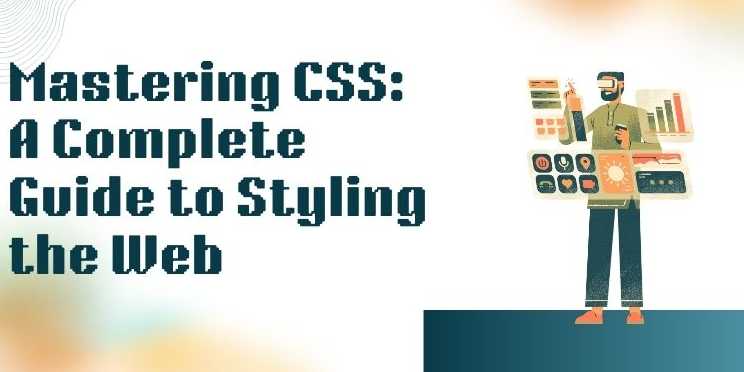Mastering CSS: A Complete Guide to Styling the Web

Chapter 2: CSS Foundations
🧠 Why This Chapter
Matters
Before building beautiful and responsive web pages, you must
first understand how CSS works at the core. This chapter lays the foundation
of styling with CSS — from syntax, structure, and different types of
stylesheets to mastering selectors and how the browser determines which styles
apply.
Mastering these basics will help you write clean,
maintainable, and conflict-free stylesheets in real-world projects.
✅ 1. What is CSS?
CSS (Cascading Style Sheets) is the language used to
style and visually format web documents written in HTML.
It allows developers to control:
- Colors
- Layouts
- Fonts
- Positioning
- Animations
- Responsive
behavior
✅ CSS separates content (HTML)
from presentation (styles).
✅ 2. History of CSS
|
Version |
Highlights |
Released |
|
CSS1 |
Fonts, colors, text, margins, padding |
1996 |
|
CSS2 |
Positioning, z-index, media types |
1998 |
|
CSS3 |
Modules (flexbox, grid, transitions, etc.) |
Ongoing |
Modern CSS (CSS3 and beyond) allows responsive designs,
animations, and advanced layouts.
✅ 3. How CSS Works (Behind the
Scenes)
- The
browser parses the HTML and builds a DOM Tree
- Then
it parses CSS and applies rules based on selectors
- It
builds a Render Tree and then paints the page
✅ CSS rules are applied in order
based on specificity, inheritance, and cascading.
✅ 4. Types of CSS
|
Type |
Description |
Example |
|
Inline |
Inside an HTML element’s style attr |
<p style="color:red;">Hi</p> |
|
Internal |
Inside <style> tags in HTML head |
<style>p { color: red; }</style> |
|
External |
In a .css file linked to HTML |
<link rel="stylesheet" href="style.css"> |
Best Practice: Always use external CSS for
scalability and separation of concerns.
✅ 5. CSS Syntax & Structure
selector
{
property: value;
}
Example:
h1
{
color: blue;
font-size: 24px;
}
|
Part |
Description |
|
selector |
Targets an HTML element |
|
property |
CSS feature (e.g., color) |
|
value |
What to apply (e.g., blue) |
✅ 6. CSS Selectors (Basic to
Advanced)
🔹 Basic Selectors
h1
{ ... } /* tag */
#title
{ ... } /* ID */
.class
{ ... } /* class */
🔹 Grouping Selectors
h1,
h2, p {
color: green;
}
🔹 Attribute Selectors
input[type="text"]
{
border: 1px solid #000;
}
🔹 Pseudo-classes
a:hover
{
text-decoration: underline;
}
li:first-child
{
font-weight: bold;
}
🔹 Pseudo-elements
p::first-letter
{
font-size: 200%;
}
✅ Combine selectors to apply
precise styles with minimal code.
✅ 7. Comments in CSS
/*
This is a CSS comment */
✅ Comments help document your
stylesheets and are ignored by browsers.
✅ 8. Specificity, Inheritance,
and Cascading Order
🔹 Specificity Rules
|
Selector Type |
Specificity Score |
|
Inline Styles |
1000 |
|
ID Selectors |
100 |
|
Class, Attr, Pseudo |
10 |
|
Element Selectors |
1 |
Example:
/* More specific due to ID */
#main
h1 {
color: red;
}
🔹 Inheritance
Some CSS properties automatically inherit from parent
elements:
- font-size
- color
- line-height
Others don’t (like margin, padding, etc.)
Use inherit, initial, or unset to manage inheritance.
🔹 Cascading Order
When multiple rules apply:
- Inline
styles win over everything
- Then
IDs
- Then
classes, attributes, and pseudo-classes
- Then
elements
✅ Use this to debug conflicts and
overrides.
✅ Recap Table: CSS Foundations
|
Concept |
Key Takeaway |
|
CSS Purpose |
Controls layout, design, and responsiveness |
|
Syntax |
Selector + Property + Value |
|
Selectors |
Match HTML elements |
|
Specificity |
Defines rule importance |
|
Inheritance |
Some properties pass to children |
|
CSS Types |
Inline, Internal, External |
FAQs
1. What is the difference between inline, internal, and external CSS?
Inline CSS is written inside HTML tags, internal CSS is placed within a <style> tag in the head, and external CSS is stored in a separate file and linked to the HTML. External CSS is preferred for maintainability.
2. What is the cascading order in CSS?
CSS applies rules in a cascading manner: browser default → external → internal → inline. Specificity, importance (!important), and source order also affect which styles are applied.
3. What is the box model in CSS?
The box model describes how elements are structured with content, padding, border, and margin. Understanding it is essential for layout and spacing.
4. What is specificity in CSS?
Specificity determines which rule takes precedence when multiple rules target the same element. Inline styles > ID selectors > Class selectors > Element selectors.
5. What is the difference between Flexbox and Grid?
Flexbox is best for one-dimensional layouts (row or column), while Grid is suitable for two-dimensional layouts (rows and columns together).
6. How do media queries work in CSS?
Media queries apply styles based on device conditions like screen width. They are essential for creating responsive websites.
7. What are pseudo-classes and pseudo-elements?
Pseudo-classes like :hover and :focus apply styles based on user interaction. Pseudo-elements like ::before and ::after style specific parts of an element.
8. Why should you avoid using !important frequently?
Using !important overrides all other rules, which can make debugging harder and affect maintainability. Use it only when absolutely necessary.
9. What tools can enhance writing CSS?
Tools like SASS, LESS, Tailwind CSS, and PostCSS help in writing cleaner, more scalable CSS with features like nesting, variables, and mixins.
10. How can CSS impact website performance?
Efficient CSS can improve load time and user experience. Avoid unnecessary styles, minimize CSS files, and use compression tools like cssnano.


Comments(0)